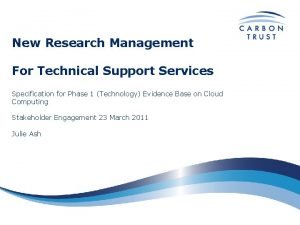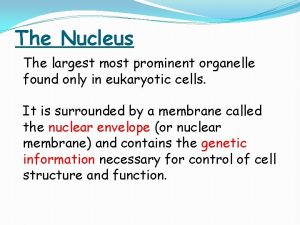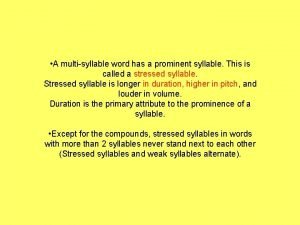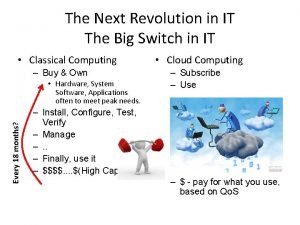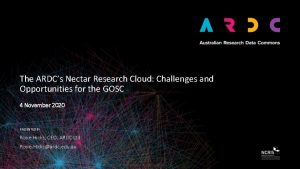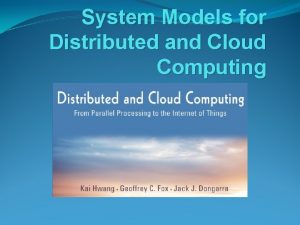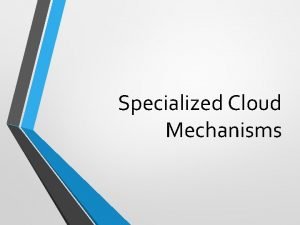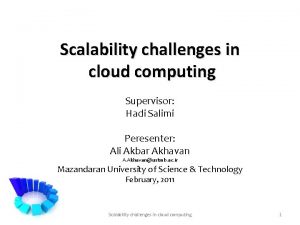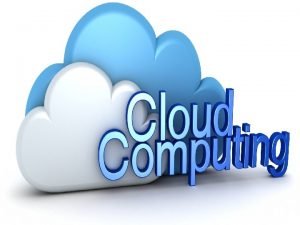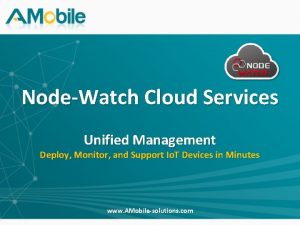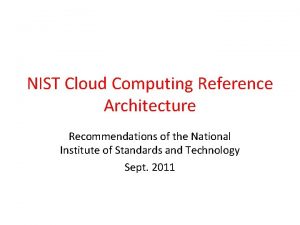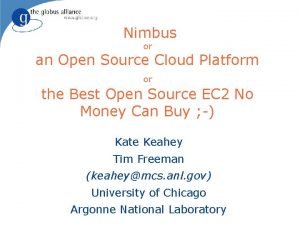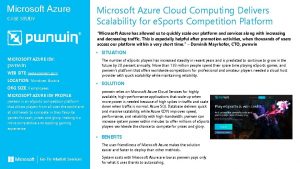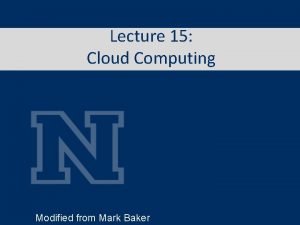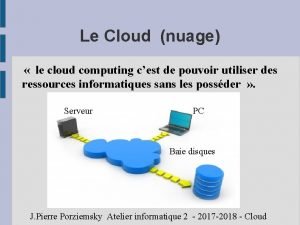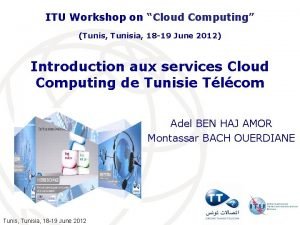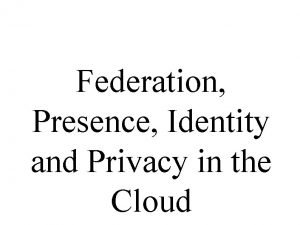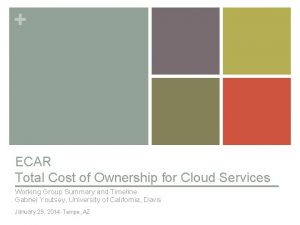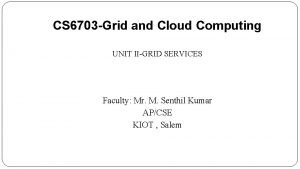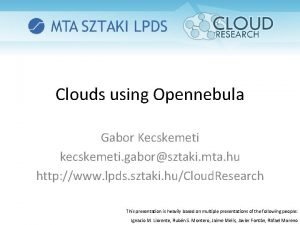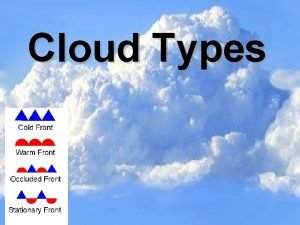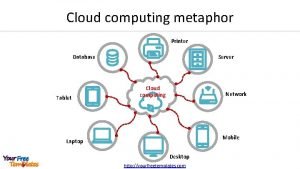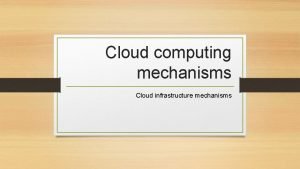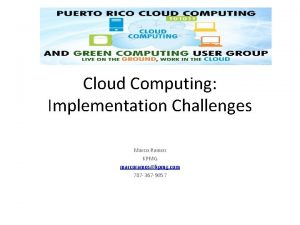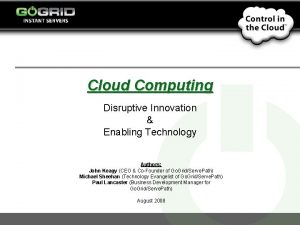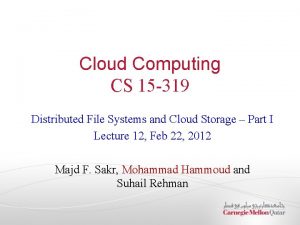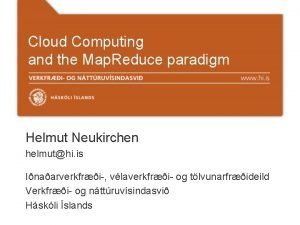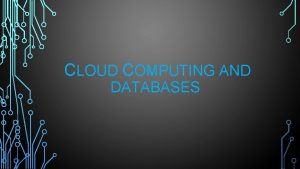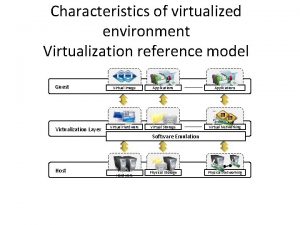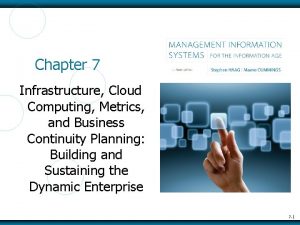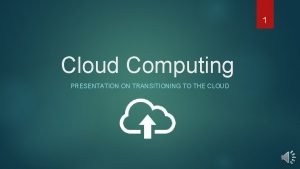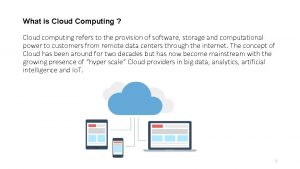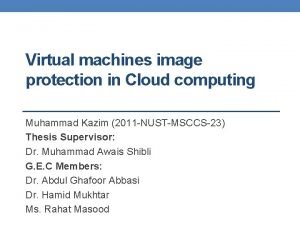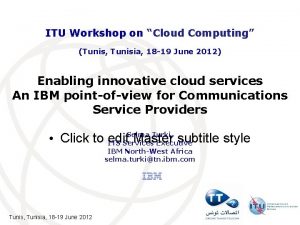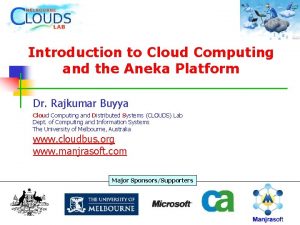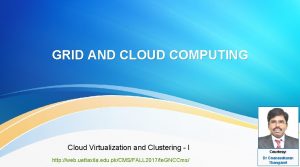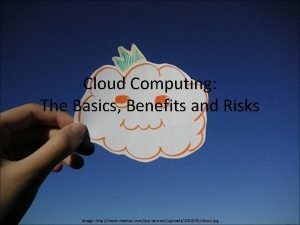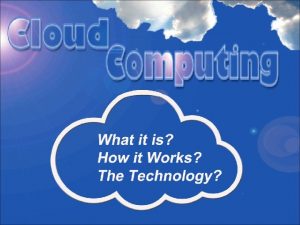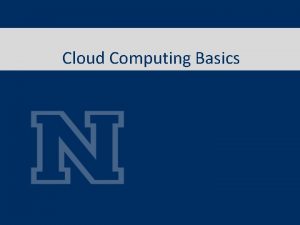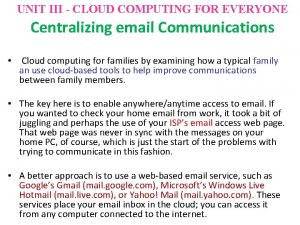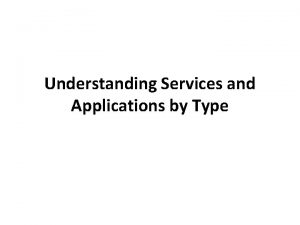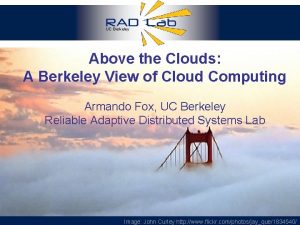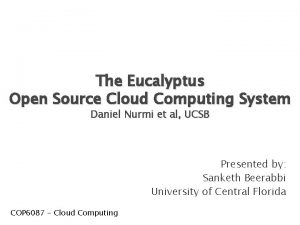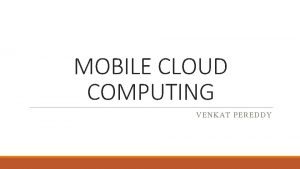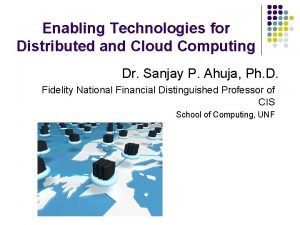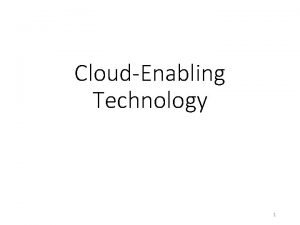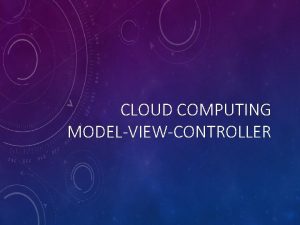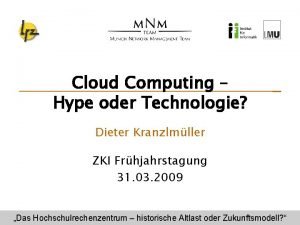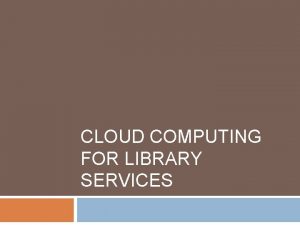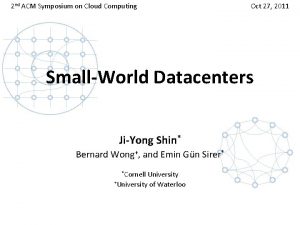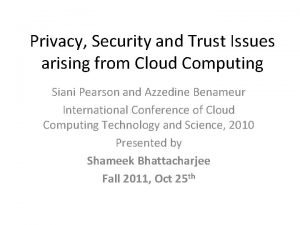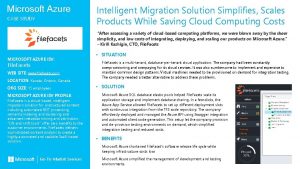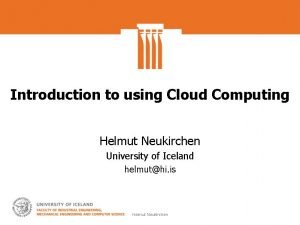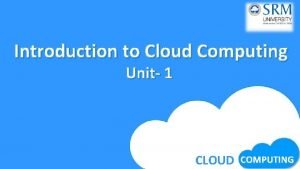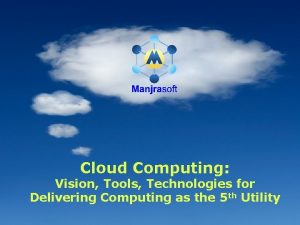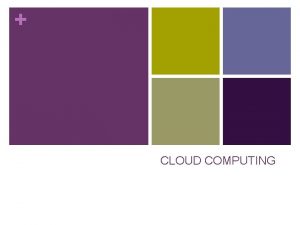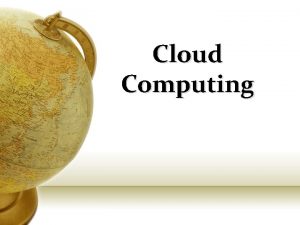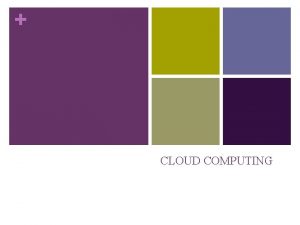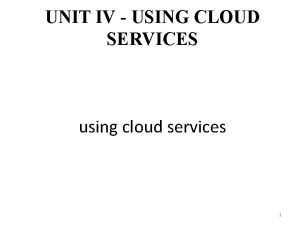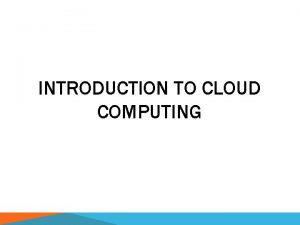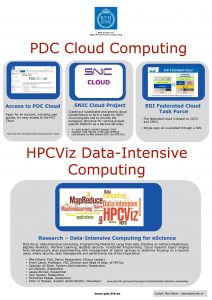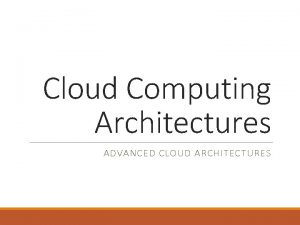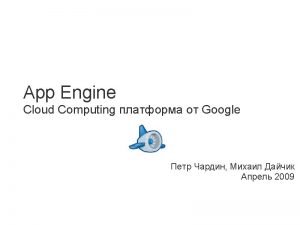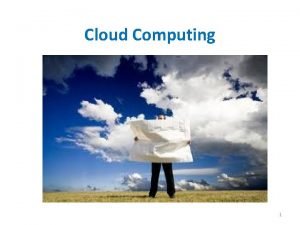CLOUD COMPUTING Module3 Using Prominent Cloud Services Using








































































































- Slides: 104

CLOUD COMPUTING Module-3 Using Prominent Cloud Services


Using Google Web Services • Google; a cloud computing services company, supports some of the largest Web sites and services in the world. • Its core business is the company’s search technology. Google uses automated technology to index the Web. • It makes its search service available to users as a standard search engine and to developers as a collection of special search tools limited to various areas of content.

• The prime commercial part of Google’s activities is its targeting advertising business: Ad. Words and Ad. Sense. • Google has developed a range of services including Google Analytics that supports its targeted advertising business. • Google applications are cloud-based applications which includes productivity applications, mobile applications, media delivery, social interactions etc. • Google’s major incomes from the sales of target advertising based on information collected from your Google account activities or through cookies placed on your system using its Ad. Words system.

Google’s cloud computing services falls under two catagories. 1. Through a set of popular applications offered to the general public, which include Google Docs, Google Health, Picasa, Google Mail, Google Earth etc 2. Through Platform as a Service developer tools such as Google App Engine (GAE). It allows developers to create and deploy Web applications without worrying about managing the basic infrastructure requirements.

Google Application Portfolio Indexed search | The Dark Web | Aggregation Disintermediation | Productivity applications and services Enterprise offerings | Ad. Words Google Analytics |Google Translate

Indexed search • Google’s search technology is based on automated page indexing and information retrieval by Web crawlers, also called spiders or robots. • Content on pages is scanned up to a certain number of words and placed into an index. • Google also caches copies of certain Web pages and stores copies of documents such as DOC or PDF files in its cache. • Its algorithm determine the importance of a particular page based on the number of quality links to that page from other sites, the use of keywords, how long the site has been available, and traffic to the site or page. That factor is called the Page. Rank.

• Google is always improving the algorithm to prevent Search Engine Optimization (SEO) strategies from gaming the system. • Based on this algorithm, Google returns what is called a Search Engine Results Page (SERP) for a query that is parsed for its keywords. • Any site can place directions in their ROBOTS. TXT file indicating whether the site can be searched or not, and if so what pages can be searched. • Sitemaps protocol control how the Google robot can work with the site.

The Dark Web • Deep Web - Sites whose Online content that isn’t indexed by search engines. This hides the content on the World Wide Web. • Any site that suppresses Web crawlers from indexing it is part of the Deep Web. Eg: Facebook • Entire networks exist that aren’t searchable, particularly peer-to-peer networks.

The Deep Web includes: ØDatabase generated Web pages or dynamic content ØPages without links ØPrivate or limited access Web pages and sites ØInformation contained in sources available through executable code such as Java. Script ØDocuments and files that aren’t in a form that can be searched, which includes media files and information in non-standard file formats

• The terms “deep web” and “dark web” are sometimes used interchangeably, but they are not the same. • Deep web refers to anything on the internet that is not indexed by and, therefore, accessible via a search engine like Google. • The dark web is a subset of the deep web that is intentionally hidden, requiring a specific browser—Tor—to access. • Not all the dark web is used for illicit purposes despite its ominous-sounding name.

Aggregation • Display of information from various sites for easy access. • Eventhough a great user service, it sometimes violates copyright laws and damages content providers.

Disintermediation • Disintermediation is the removal of intermediaries such as a distributor, agent, broker, or some similar functionary from a supply chain. • This connects producers directly with consumers, which in many cases is a very good thing. • But it impacted organizations such as news collection agencies, publishers, retail outlets, and many other businesses, which played a positive role in the transactions they were involved in.

Productivity Applications and Services • These products store your information online in a form that Google can use to build a profile of your activities. • Company uses these informations it stores to deliver personalises services and products.

Enterprise Offerings • The following are among Google’s products aimed at the enterprise market: • Google Commerce Search: A search service for online retailers that markets their products in their site searches with a number of navigation, filtering, promotion, and analytical functions. • Google Site Search: Customized search engine for enterprises under the Google Site Search service banner. The user enters a search string in the site’s search, and Google returns the results from that site.

• Google Search Appliance(GSA): This server can be deployed within an organization to speed up both Intranet and Internet searching. These appliances have document management features, perform custom searches, cache content, and give local support to Google Analytics and Google Sitemaps. • Google Mini: A smaller version of the GSA. • Google uses different names for the different bundles(such as governments, schools, non-profits, and ISPs) under a branded program called Google Apps for Business. • For business and other organizations such as governmental agencies, the company has a branded Google Apps Premier Edition, which is a paid service. The different versions offer Gmail, Docs, and Calendar as core applications.

Ad. Words • Ad. Words is a targeted ad service based on matching advertisers and their keywords to users and their search profiles. • Responsible for the majority of Google’s revenue stream. • Similar to Microsoft adcenter and Yahoo Search Marketing • Ads are displayed as text, banners, or media and can be tailored based on geographical location, frequency, IP addresses, and other factors. • Ad. Words ads can appear in Google. com, AOL search, Ask. com, and Netscape etc and Other partners belonging to the Google Display Network.

• In all these cases, the Ad. Words system determines which ads to match to the user searches. • Advertisers bid on keywords that are used to match a user to their product or service. • Google gets paid for the ad whenever a user clicks it. • The system is referred to as pay-per-click advertising, and the success of the ad is measured by click-through rate (CTR). • Google calculates a quality score for ads based on the CTR, the strength of the connection between the ad and the keywords, and the advertiser’s history with Google. • This quality score is used to price the minimum bid of a keyword.

Google Analytics • A statistical tool that measures the number and types of visitors to a Web site and how the Web site is used. • It is offered as a free service and has been adopted by many Web sites. • Analytics works by using a Java. Script snippet called the Google Analytics Tracking Code (GATC) on individual pages to implement a page tag.

• When the page loads, the Java. Script runs and creates a browser cookie that can be used to manage return visitors, perform tracking, test browser characteristics, and request tracking code that identifies the location of the visitor. • GATC requests and stores information from the user’s account and it sends back to GA servers for processing. • GA aggregates the data and presents the information in a visual form. • GA also is connected to the Ad. Words system so it can track the performance of particular ads in different contexts.

Google Translate • Google Translate was introduced in 2007. • Google Translate performs machine translation of language as a cloud service to several languages. • Translate uses a corpus linguistics approach to translation. • The text-corpus method is a digestive approach that derives a set of abstract rules that govern a natural language from texts in that language, and explores how that language relates to other languages.

• Google Translate can be used in the following ways: ØEnter text directly into the text box, and click the Translate button to have the text translated. ØEnter a URL for a Web page to have Google display a copy of the translated Web page. ØEnter a phonetic equivalent for script languages. ØUpload a document to the page to have it translated. • Translate parses the document into words and phrases and applies its statistical algorithm to make the translation.

GT and GAE • Google Toolkit • Google APIs • Google App Engine

Exploring the Google Toolkit • Google has an extensive program that supports developers who want to leverage Google’s cloudbased applications and services. • Google has a number of areas in which it offers development services, including the following: ØAJAX APIs: used to build widgets and other applets commonly found in places like i. Google. AJAX provides access to dynamic information using Java. Script and HTML. ØAndroid: is a phone operating system development.

ØGoogle App Engine: is Google’s Platform as a Service (Paa. S) development and deployment system for cloud computing applications. ØGoogle Apps Marketplace: offers application development tools and a distribution channel for cloudbased applications. ØGoogle Gears: is a service that provides offline access to online data. It includes a database engine installed on the client that caches data and synchronizes it. ØGoogle Web Toolkit: is a set of development tools for browser-based applications. Open-source platform. Allows developers to create AJAX applications using Java or with the GWT compiler using Java. Script. ØProject Hosting: is a project management tool for managing source code.

Google APIs • Google’s APIs can be categorized as belonging to the following categories: Ø Ads and Ad. Sense: These APIs allow Google’s advertising services to be integrated into Web applications. Eg: Ad. Words, Ad. Sense, and Google Analytics. Ø AJAX: Provide a means to add content such as RSS feeds, maps, search boxes, and other information sources by including a snippet of Java. Script into your code.

Ø Browser: Related to building browser-based applications. Eg: Google Cloud Print API, Installable Web Apps API(for creating installation packages), the Google Web Toolkit (for building AJAX applications using Java), V 8 (a high-performance Java. Script engine). Ø Data: The Data APIs exchange data with a variety of Google services. Eg: Google Apps, Google Analytics, Blogger, Calendar, Code Search, Google Earth, Google Spreadsheets, Picasa. Web Albums. Ø Geo: Give location-specific information hooking into maps and geo-specific databases. Eg: Google Earth, Directions, Java. Scripts Maps, Maps API for Flash, and Static Maps.

Ø Search: The search APIs leverage Google’s core competency and its central service. Eg: APIs such as Google AJAX Search, Book Search, Code Search, Custom Search, and Webmaster Tools Data APIs allow developers to include Google searches in their applications and websites. Ø Social: For information exchange and communication tools. Eg: Gmail, Calendar, and others, and they provide a set of foundation services. The popular social APIs are Blogger Data, Calendar, Contacts, Open. Social, Picasa, and You. Tube.

Google App Engine (GAE) • Google App Engine (GAE) is a Platform as a Service (Paa. S) cloud-based Web hosting service on Google’s infrastructure. • This service allows developers to build and deploy Web applications and have Google manage all the infrastructure needs, such as monitoring, failover, clustering, machine instance management etc. • For an application to run on GAE, it must comply with Google’s platform standards.

GAE supports the following major features: ØDynamic Web services based on common standards ØAutomatic scaling and load balancing ØAuthentication using Google’s Accounts API ØPersistent storage, with query access sorting and transaction management features ØTask queues and task scheduling ØA client-side development environment for simulating GAE on your local system ØOne of either two runtime environments: Java or Python

• Google allows for free application development and deployment up to a certain level of resource consumption; beyond the free limit is generally on a pay-as-you-go basis. • Applications running in GAE are isolated from the underlying operating system, which Google describes as running in a sandbox. • This allows GAE to optimize the system so Web requests can be matched to the current traffic load. • It also allows applications to be more secure because applications can connect only to computers using the specified URLs and fetch services using HTTP or HTTPS over the standard well-known ports.

• Applications can only read files; they cannot write to the file system directly. • To access data, an application must use data stored in the memcache (memory cache). Memcache is a fast in-memory key-value cache that can be used between application instances. • An application responds only to a specific HTTP request—in real-time, part of a queue, or scheduled • GAE has a distributed datastore system that supports queries and transactions. • The datastore uses an optimistic concurrency control and maintains strong consistency.

• To support the distributed nature of the datastore, the concept of an entity group is employed. Transactions manage entities as a single group, and entity groups are stored together in the system so operations can be performed faster. • The App Engine relies on the Google Accounts API for user authentication


Using Amazon Web Services • Amazon Web Services is based on SOA standards, including HTTP, REST and SOAP transfer protocols, open source and commercial operating systems, application servers, and browser-based access. • Amazon. com’s services represent the largest pure Infrastructure as a Service (Iaa. S) in the marketplace today.

Amazon Web Service Components and Services 1. Amazon Elastic Compute Cloud (EC 2): enables the creation, use, and management of virtual private servers running the Linux or Windows operating system over a Xen hypervisor. ØAmazon Simple Queue Service (SQS): is a message queue or transaction system for distributed Internet-based applications. ØAmazon Simple Notification Service (SNS): a Web service that can publish messages from an application and deliver them to other applications or to subscribers.

ØAmazon Cloud. Watch: To monitor EC 2. Provides a view of resource utilization, performance metrics and operational indicators for processor demand, disk utilization, and network I/O. ØAuto Scaling: Automatically scale an EC 2 site based on a set of rules that you create. The metrics are obtained by Cloud. Watch. ØElastic Load Balancing feature: To load balance Amazon Machine Instances (AMIs) in EC 2. Amazon Simple Storage System (S 3): An online backup and storage system.

3. AWS Import/Export: A high speed data transfer feature to transfer data to and from AWS using Amazon’s own internal network to portable storage devices. 4. Amazon Elastic Block Store (EBS): A system for creating virtual disks (volume) or block level storage devices that can be used for Amazon Machine Instances in EC 2. 5. Amazon Simple. DB: a structured data store that supports indexing and data queries to both EC 2 and S 3. It stores data in “buckets” and without requiring the creation of a database schema.

6. Amazon Relational Database Service (RDS): allows to create instances of the My. SQL database to support your Web sites and the many applications that rely on data-driven services. 7. Amazon Cloudfront: an edge-storage or contentdelivery system that caches data in different physical locations so that user access to data is enhanced through faster data transfer speeds and lower latency.

Elastic Compute Cloud (EC 2) • Amazon Machine Images • Pricing models • System images and software • Creating an account and instance on EC 2

Working with the Elastic Compute Cloud (EC 2) • Amazon EC 2 is a virtual server platform that allows users to create and run virtual machines on Amazon’s server farm. • With EC 2, you can launch and run server instances called Amazon Machine Images (AMIs) running different OS such as Red Hat Linux and Windows on servers that have different performance profiles. • You can add or subtract virtual servers elastically as needed; cluster, replicate, and load balance servers; and locate your different servers in different data centers or “zones” throughout the world to provide fault tolerance.

• The term elastic refers to the ability to size your capacity quickly as needed. Instance and a machine image • An instance is the emulation of a hardware platform such as X 86, IA 64, and so on running on the Xen hypervisor. • A machine image is the software and OS running on top of the instance. • It is something that you could package up with a program to create a single file containing the exact contents of a volume. • A machine image should be composed of a hardened OS with as few features and capabilities as possible and locked down as much as possible.

Amazon Machine Images • AMIs are operating systems running on the Xen virtualization hypervisor. • Each virtual private server is accorded a size rating called its EC 2 Compute Unit. 1. Standard Instances: They are deemed to be suitable for standard server applications. 2. High Memory Instances: Useful for large data throughput applications such as SQL Server databases and data caching and retrieval. 3. High CPU Instances: Used for applications that are processor- or compute-intensive. Applications of this type include rendering, encoding, data analysis, and others.

Pricing models • The pricing of these different AMI types depends on the operating system used, which data center the AMI is located in (you can select its location), and the amount of time that the AMI runs. • Rates are quoted based on an hourly rate. • Pricing varies by zone, instance, and pricing model. System images and software • You can choose a template AMI system image with the OS of your choice or create your own system image that contains your custom applications, code libraries, settings, and data.

• Security can be set through passwords, Kerberos tickets, or certificates. • The OS like RHEL, Windows Server, Sun Open. Solaris, Oracle Enterprise Linux, Open. Suse, Ubuntu Linux and Debian are offered • Use of Elastic IP Address feature in virtual private server, creates a static IP V 4 address to your server. This address can be mapped to any of your AMIs and is associated with your AWS account. • You retain this IP address until you release it from your AWS account. • When a machine instance fail, you can map your Elastic IP Address to fail over to a different AMI.

Creating an account and instance on EC 2 • The process for signing up for AWS, creating an AMI, and provisioning the image with software requires following steps: • For signing up for AWS: Ø Sign Up to AWS. Ø Name your account, provide a password and select a payment option. Ø Sign into the Amazon EC 2 Management Console.

• To create an AMI instance: Ø Click the Launch Instance button. Ø Select the type of system image you want. Ø Specify the Number of Instance(s), the Availability Zone and the Instance type. Ø Enter Kernal ID and enable Cloud. Watch. Ø Create a Key Pair. Ø Configure Firewall. Ø Review the settings. Ø Run and connect to the instance.

Amazon Storage Systems • Amazon Simple Storage System (S 3) • Amazon Elastic Block Store (EBS) • Cloud. Front

Working with Amazon Storage Systems • When you create an AMI the storage allocated is temporal; it only exists for as long as your instance is running. • All of the data contained in that storage is lost when the instance is suspended or terminated, as the storage is reassigned to other AWS users to use. • So, you need to have access to persistent storage.

Amazon Simple Storage System (S 3) • Amazon S 3’s cloud-based storage system allows you to store data objects ranging in size from 1 byte up to 5 GB in a flat namespace. • In S 3, storage containers are referred to as buckets, which serves the functions of a directory. • There is no object hierarchy to a bucket, and you save objects and not files to it. • It is important that you do not associate the concept of a filesystem with S 3, because files are not supported; only objects are stored.

• The S 3 system allows you to assign a name to a bucket, but that name must be unique in the S 3 namespace across all AWS customers. • Access to an S 3 bucket is through the S 3 Web API (either with SOAP or REST). • S 3’s performance limits use to non-operational functions such as data archiving and retrieval or disk backup.

• You can do the following with S 3 buckets through the APIs: Ø Create, edit, or delete existing buckets Ø Upload new objects to a bucket and download them Ø Search for and find objects and buckets Ø Find metadata associate with objects and buckets Ø Specify where a bucket should be stored Ø Make buckets and objects available for public access

• Versioning option is available for Amazon S 3. • With versioning feature is enabled, every version of an object stored in an S 3 bucket is retained. • Versioning is used for preserving data and for archiving purposes. • Amazon S 3 provides large quantities of reliable storage that is highly protected but to which you have low bandwidth access. • S 3 excels in applications where storage is archival in nature.

Amazon Elastic Block Store (EBS) • EBS create virtual drives that can be used with your machine instances in the same way that you would use a hard drive with a physical system. • EBS tends to be used in transactional systems where high-speed data access is required. • A persistent storage service with a high operational performance. • It can store file system information and its performance is higher and much more reliable than Amazon S 3.

• The cost of creating an EBS volume is greater than creating a similarly sized S 3 bucket. • An EBS volume can be used as an instance boot partition. • The advantages of an EBS boot partition: Ø Can have a volume up to 1 TB. Ø Retain your boot partition separately from your EC 2 instance. Ø Use a boot partition volume as a means for bundling an AMI into a single package. Ø EBS boot partitions can be stopped and started. Ø They offer fast AMI boot times.

• EBS create block storage volumes varying in size from 1 GB to 1 TB and make those volumes available to your machine instances. • The created volumes must be formatted for use. • A volume is mounted on a particular instance and is available only to that instance; i. e, volumes may not be shared between instances. • Volumes appear as if they are physical drives attached to an instance. • Multiple volumes can be mounted on a single instance and create striped RAID volumes for faster performance. • You can make an instance image or snapshot of your AMI, and these point-in-time snapshots are then copied out to Amazon S 3.

• You can use these snapshots as system images to create new AMIs or to restore a volume to that pointin-time snapshot when needed. • Snapshots can be shared with authorized users using Snapshot Permissions command. • When you create a new volume from an S 3 snapshot, the data is slowly copied to the new volume. • As you start working on the new volume, any missing data is downloaded preferentially as needed.

Cloud. Front • Cloud. Front represents another level of Amazon cloud storage. • Amazon Cloud. Front is referred to as a Content Delivery Network (CDN) or Edge Computing. • In edge computing, content is pushed out geographically so the data is more readily available to network clients and has a lower latency when requested. • CDN is like a distributed caching system. • Cloud. Front servers are located throughout the world. • A user requesting data from a Cloud. Front site is referred to the nearest geographical location.

• Cloud. Front supports “geo-caching” data by performing static data transfers and streaming content from one Cloud. Front location to another. • A Cloud. Front domain name is registered for your domain name in the form <domainname>. cloudfront. net. • Objects in the Cloud. Front domain can be mapped to your own domain. • Source files on Cloud. Net servers are stored in Amazon S 3 buckets and then use the Cloud. Front API to register the S 3 bucket with the Cloud. Net distribution. • Then in your applications, Web pages, and links, you reference the distribution location.

Amazon Database Services • Amazon Simple. DB • Amazon Relational Database Service

Amazon Database Services • Amazon offers two different types of database services: Ø Amazon Simple. DB (non-relational) Ø Amazon Relational Database Service (Amazon RDS)

Amazon Simple. DB • Amazon Simple. DB is an attempt to create a high performance data store with many database features. • The service is meant to be low touch, in that it abstracts many of the common concerns of database administrators for hardware requirements, software maintenance, indexing, and performance optimization. • To create a high performance “simple” database, the data store is non-relational and joins are not supported.

• Data stored in Simple. DB domains are easily scalable and highly available. • Transactions are performed as a set of conditional PUTS and DELETES, and you can INSERT, REPLACE, or DELETE values for item attributes. • Features like ROLLBACK are not supported. • Optimistic concurrency control is maintained using the value of a counter or timestamp. • Capacity of Simple. DB database can be increased by scaling out and creating additional data domains.

• Simple. DB integrates with EC 2 instances and S 3 storage. • Data in Simple. DB is automatically indexed and may be queried as needed. • A data domain may be located geographically in any of AWS’s regions. • Featured uses of Simple. DB are data logging, online gaming, and metadata indexing. • Simple. DB would not be the best choice for a highvolume transaction system.

Amazon Relational Database Service (RDS) • Amazon RDS is a simplified variant of the My. SQL 5. 1 database system. • RDS allow database applications that already exist to be ported to RDS and placed in an environment that is relatively automated and easy to use. • RDS automatically performs functions such as backups and is deployable throughout AWS zones using the AWS infrastructure. • RDS is started by launching a DB instance in the AWS Management Console and assigning the DB Instance class and size of the data store.

• The DB Instance is then connected to your My. SQL database. • Any database tool that works with My. SQL 5. 1 will work with RDS. • Additionally, you can monitor your database usage as part of Amazon Cloud. Watch. • Important features of RDS is the automated point-in -time backup system for data in the DB as well as for the My. SQL transaction logs. • RDS supports database snapshots. A DB Snapshot is stored as a full DB backup and is retained until you delete it from your storage container.

Choosing a database for AWS • Choose Simple. DB ü When index and query functions do not require relational database support. ü For the lowest administrative overhead. ü If you want a solution that autoscales on demand. ü For a solution that has a very high availability.

• Use RDS ü When you have an existing My. SQL database that could be ported ü When you want to minimize the amount of infrastructure and administrative management required. ü When your DB queries require relation between data objects. ü When you want a DB that scales based on an API call and has a pay-as-you-use-it pricing model.

• Select Amazon EC 2/Relational Database AMI ü When you want access to an enterprise relational DB or have an existing investment in that particular application. ü To retain complete administrative control over your database server.


Using Microsoft Cloud Services • Azure is a combination of virtualized infrastructure to which the. NET Framework has been added as a set of. NET Services. • The Windows Azure service itself is a hosted environment of virtual machines enabled by a fabric called Windows Azure App. Fabric. • Applications can be hosted on Azure and provision it with storage, growing it as you need it. • Windows Azure service is an Infrastructure-as-a. Service(Iaa. S) offering.

• Azure and its related services were built to allow developers to extend their applications into the cloud. • Azure is a virtualized infrastructure to which a set of additional enterprise services has been layered on top, including: ØAzure App. Fabric: A virtualization service that creates an application hosting environment. Formerly known as. NET Services. It is a cloudenabled version of the. NET Framework. ØStorage: A high capacity non-relational storage facility. ØCompute: A set of virtual machine instances.

ØSQL Azure Database: A cloud-enabled version of SQL Server. ØDallas: A database marketplace based on SQL Azure DB. ØDynamics CRM: An x. RM (Anything Relations Management) service based on Microsoft Dynamics. ØShare. Point Services: A document and collaboration service based on Share. Point. ØWindows Live Services: A collection of services that runs on Windows Live, which can be used in applications that run in the Azure cloud.

How does Microsoft Azure work

Defining Windows Azure Platform • Software plus Services approach • Azure Platform | Windows Azure service • Windows Azure App. Fabric • Azure Content Delivery Network • SQL Azure | Windows Azure pricing • Windows Live services

Defining Windows Azure Platform • Windows Azure is both Iaa. S and Paa. S service offering. • Azure is Iaa. S and Azure Platform is Paa. S. • A developer creates an Azure application by logging onto the Azure portal and creating a Windows Live ID, a hosted account, and a storage account. • The completed application can then be made available to users as a hosted application or service.

Software plus Services approach • Microsoft sees the cloud as being a complimentary platform to its other platforms. • Microsoft developer can extend his application’s availability to the cloud. • The application runs on a server, desktop, or mobile device running some form of Windows. • Microsoft calls this approach software plus services.

• The approach provides benefits of both traditional physical-based software and Web-based software-as -a-service (Saa. S) delivery methods. • The Windows Azure Platform allows a developer to modify his application so it can run in the cloud on virtual machines hosted in Microsoft datacenters. • Windows Azure serves as a cloud OS and the application can be hosted on Azure as a runtime application where it can make use of the various Azure Services.

The Azure Platform • With Azure’s architecture, an application can run locally, run in the cloud, or some combination of both. • Applications on Azure can be run as applications, as background processes or services, or as both. • The Windows Azure service is a cloud-based OS with a fabric infrastructure of virtual machines hosted in Microsoft datacenters. • The Azure Windows Services Platform API uses the industry standard REST, HTTP, and XML protocols.

• Developers can install a client-side managed class library that contains functions that can make calls to the Azure Windows Services Platform API as part of their applications. • These API functions have been added to Microsoft Visual Studio as part of Microsoft’s Integrated Development Environment (IDE). • The Azure Service Platform hosts runtime versions of. NET Framework applications

• Azure can deploy Web-based applications built with ASP. NET, the Windows Communication Foundation (WCF), and PHP, and it supports Microsoft’s automated deployment technologies. • Microsoft also has released software development kit for both Java and Ruby to place calls to the Azure Service Platform API to the App. Fabric Service.

The Windows Azure Service • Six main elements are part of Windows Azure: ØApplication: This is the runtime of the application that is running in the cloud. ØCompute: This is the load-balanced Windows server computation and policy engine that allows you to create and manage virtual machines that serve either in a Web role and a Worker role. ØStorage: This is a non-relational storage system for large-scale storage. ØFabric: This is the Windows Azure Hypervisor, which is a version of Hyper-V that runs on Windows Server 2008.

ØConfig: This is a management service. ØVirtual machines: These are instances of Windows that run the applications and services that are part of a particular deployment. • The portion of the Azure environment that creates and manages a virtual resource pool is called the Fabric Controller. • Applications that run on Azure are memorymanaged, load-balanced, replicated, and backed up through snapshots automatically by the Fabric Controller.


Windows Azure App. Fabric • It is a Service Bus and Access Control facility based on. NET technology for client requests to Web services on Azure. Previously, known as Microsoft. NET Services. • Supports the standard SOA protocols such as REST and SOAP and the WS- protocols. • Microsoft refer Azure App. Fabric as an “Internet Service Bus”. • App. Fabric has components such as service orchestration, federated identity, access control, a namespace, service registry, and a messaging fabric, but it locates these components in the cloud.

• The function of a service bus is to expose distributed services as an endpoint with a specific Uniform Resource Identifier (URI) that clients can request services from. • A particular set of endpoints and its associated Access Control rules for an application is referred to as the service namespace. • Each namespace is assigned a management key that is part of the security mechanism. • Azure App. Fabric manages requests by locating the service, communicating the request, and making the necessary connection possible by performing network address translation, opening appropriate ports in any intervening firewalls.


• App. Fabric manages the transaction to ensure that it is completed and that a response is sent to the client. • A service bus also negotiate the exchange of information between a client and the service. • App. Fabric can provide a negotiated traversal of services through firewalls and NATs (Network Address Traversal). • The Access Control portion of Azure App. Fabric provides a token-based trust mechanism for identity management. An application or user, presents a claim for a service from an application. • The Access Control examines the request, and if it finds it to be valid, it grants a security token to the client.

Steps in access control: Ø Client requests authentication from Access control. Ø Access control creates a token based on the stored rules for server application. Ø A token is signed and returned to the client application. Ø The client presents the token to the service application. Ø Server application verifies the signature and uses the token to decide what the client application is allowed to do.


Azure Content Delivery Network • It is a worldwide content caching and delivery system for Windows Azure blob content. • CDN is an edge network service that lowers latency and maximizes bandwidth by delivering content to users who are nearby. • Any storage account can be enabled for CDN. • In order to share information stored in an Azure blob, it has to be placed in a public blob container that is accessible to anyone using an anonymous sign-in.

• When the Blob service URL is used, the request is redirected to the closest CDN endpoint to the client. • The CDN service searches that location and serves the content. • If the content isn’t found, the CDN retrieves the Blob from the Blob service, caches the content, and then serves it to the user. Azure Blob storage is a service that stores unstructured data in the cloud as objects/blobs. Blob storage can store any type of text or binary data, such as a document, media file, or application installer. Blob storage is also referred to as object storage.

SQL Azure • SQL Azure is a cloud-based relational database service that is based on Microsoft SQL Server. • Initially, this service was called SQL Server Data Service. • An application that uses SQL Azure Database can run locally on a server, PC, or mobile device, in a datacenter, or on Windows Azure. • Data stored in an SQL Azure database is accessed using the Tabular Data Stream (TDS) protocol, the same protocol used for a local SQL Server database. • SQL Azure Database supports Transact-SQL statements.

• Azure data is replicated three times for data protection and writes are checked for consistency. • SQL Azure eventually will support the Microsoft Sync Framework providing a facility for SQL Azure DB to synchronize their data with local DB. • Current limit of each SQL Azure Database is 10 GB. • If the storage size exceeds the limit, then data must be partitioned into logical sets and queries need to be structured to account for this partitioning. • SQL Azure Database is a shared database environment, and limitations are placed on how long a query can run or how many resources a query can use.

Windows Azure pricing • Prices for working with the Windows Azure Platform are based either on a “consumption” (pay-as-you-go) model or through various contracts for levels of monthly service that Microsoft calls “commitments. ” • When you exceed the subscription level of your commitment, the additional usage is charged on the consumption model.

Windows Live services • Windows Live is a collection of cloud-based applications and services, some of which can be used inside applications that run on Windows Azure Platform. • Some of them run as standalone applications and are available to users directly through a browser. • Others are services that add capabilities to the Windows Azure Platform as part of Microsoft’s software plus services strategy.

• Windows Live applications including Windows Mail, Windows Photo Gallery, and Windows Movie Maker were rolled into a downloadable software suite called Windows Live Essentials. • Some parts of the Windows Live portfolio are shared applications and services that are accessible to developers. • Developers access the services for Windows Live Services through a collection of APIs and controls called Windows Live Messenger Connect. • Using these APIs and controls, developers can add Windows Live Services capabilities and data to their application.

Using Windows Live • Windows Live includes several popular cloud-based services. • The two best known and most widely used are Windows Live Hotmail and Windows Live Messenger. • Windows Live is based around five core services: Ø E-mail Ø Instant Messaging Ø Photos Ø Social Networking Ø Online Storage

• A user or application can consume Windows Live in a number of ways. ü Some are entirely cloud-based Web services which are accessed using a browser. ü Some are aimed at mobile devices and are referred to as Windows Live for Mobile, and are accessed using mobile devices. ü Some are client-side applications that are download from Windows Live for use on your desktop.

Windows Live Essentials • A collection of client-side applications that must be downloaded and installed on a desktop. • Live Essentials rely on cloud-based services for their data storage and retrieval, and in some cases for their processing. • All the Windows Essentials are downloaded as a single file. • Live Essentials currently includes the following: Ø Family Safety Ø Windows Live Messenger Ø Photo Gallery Ø Mail Ø Movie Maker

Windows Live Home • Windows Live Home is the central access page or portal for the Windows Live suite. • The page provides navigation, lists activities, provides access to e-mail, shows your RSS feeds, and lists your account name and some related information. • This page is customizable and depends on the services to which you are subscribed.

• These are the most commonly used features on Windows Live Home: ü Launching other Windows Live services ü Viewing e-mail headers from Hotmail and private messages from other users ü Viewing activity of people you follow ü Displaying weather information and RSS feed updates ü Managing calendars and events ü Viewing photos ü Modifying profile and relationships

Windows Live for Mobile • Windows Live services that are specifically meant to be run on mobile devices or cell phones. • Some of these services run on the Windows Mobile platform, some are Web-based applications that conform to the lightweight Wireless Application Protocol (WAP) or on GPRS (General Packet Radio Service) browser, and some support SMS (Simple Message Service) systems.

• Services includes: Ø Live Mesh Mobile Ø Windows Live Calendar Mobile Ø Windows Live Contacts Mobile Ø Windows Live Groups Mobile Ø Windows Live Home Mobile Ø Windows Live Messenger Mobile Ø Windows Live Office Mobile Ø Windows Live Profile Mobile Ø Windows Live Sky. Drive Mobile Ø Windows Live Spaces Mobile
 A composable component must be modular
A composable component must be modular Technical services support cloud computing
Technical services support cloud computing Conventional computing and intelligent computing
Conventional computing and intelligent computing Most prominent organelle in eukaryotic cells
Most prominent organelle in eukaryotic cells Offering incentives for charitable acts essay
Offering incentives for charitable acts essay Consensus advantages and disadvantages
Consensus advantages and disadvantages For centuries prominent thinkers have pondered
For centuries prominent thinkers have pondered Christianity vs judaism vs islam chart
Christianity vs judaism vs islam chart What macromolecule is a prominent part of animal tissues
What macromolecule is a prominent part of animal tissues Abstract foreshadowing examples
Abstract foreshadowing examples Nameplate in newsletter
Nameplate in newsletter Basically stressed syllable
Basically stressed syllable Prominent x descent
Prominent x descent Absent y descent
Absent y descent Prominent ischial spine
Prominent ischial spine Vodafone the cloud business
Vodafone the cloud business Hardware assisted virtualization in cloud computing
Hardware assisted virtualization in cloud computing Virtualization structures in cloud computing ppt
Virtualization structures in cloud computing ppt A type of cloud
A type of cloud Cloud computing reference model
Cloud computing reference model Nectar cloud computing
Nectar cloud computing All resources are tightly coupled in computing paradigm of
All resources are tightly coupled in computing paradigm of Specialized cloud mechanisms
Specialized cloud mechanisms Mobikida
Mobikida Scalability issues in cloud computing
Scalability issues in cloud computing Conclusion for cloud computing
Conclusion for cloud computing Unified management software in cloud computing
Unified management software in cloud computing Reference
Reference Nimbus cloud computing
Nimbus cloud computing Cloud computing cambridge
Cloud computing cambridge Case study on microsoft azure in cloud computing
Case study on microsoft azure in cloud computing Cloud computing layers
Cloud computing layers Regarder introduction to cloud computing
Regarder introduction to cloud computing Sejarah cloud computing
Sejarah cloud computing Kentico cloud
Kentico cloud Cloud computing tunisie
Cloud computing tunisie Permissive federation in cloud computing
Permissive federation in cloud computing Enterprise cloud computing paradigm
Enterprise cloud computing paradigm Total cost of ownership in cloud computing
Total cost of ownership in cloud computing What is ogsa
What is ogsa Cloud computing cmu
Cloud computing cmu Collaborating via social networks in cloud computing
Collaborating via social networks in cloud computing Opennebula architecture in cloud computing
Opennebula architecture in cloud computing What are clouds
What are clouds Google app engine in cloud computing
Google app engine in cloud computing Cloud computing metaphor
Cloud computing metaphor Logical network perimeter can
Logical network perimeter can Introduction to mapreduce in cloud computing
Introduction to mapreduce in cloud computing Kpmg cloud computing
Kpmg cloud computing Cloud computing newcastle
Cloud computing newcastle Cloud computing as a disruptive technology
Cloud computing as a disruptive technology Cloud computing programming models
Cloud computing programming models Gfs in cloud computing
Gfs in cloud computing Cloud computing capacity
Cloud computing capacity Benefits and challenges of cloud computing
Benefits and challenges of cloud computing Map reducing in cloud computing
Map reducing in cloud computing Cloud computing databases
Cloud computing databases Machine reference model in cloud computing
Machine reference model in cloud computing Cloud computing metrics
Cloud computing metrics Cloud computing theory and practice
Cloud computing theory and practice Cloud computing value proposition
Cloud computing value proposition Cloud computing ppt 2019
Cloud computing ppt 2019 Internet and cloud computing presentation
Internet and cloud computing presentation Traditional cloud computing
Traditional cloud computing Machine image in cloud computing
Machine image in cloud computing Garth gibson
Garth gibson Measuring cloud computing costs
Measuring cloud computing costs Cloud computing tunisie
Cloud computing tunisie Portalaneka
Portalaneka Globus toolkit architecture in cloud computing
Globus toolkit architecture in cloud computing Virtualization of clusters in cloud computing
Virtualization of clusters in cloud computing App.gis-div/pcs web
App.gis-div/pcs web Geni lab
Geni lab Cloud computing benefits and risks
Cloud computing benefits and risks Cloud computing network topology
Cloud computing network topology Dryad in cloud computing
Dryad in cloud computing Prs.saa
Prs.saa Cloud computing basics
Cloud computing basics Cloud computing michael miller ppt
Cloud computing michael miller ppt Cloud computing artinya
Cloud computing artinya Cloud computing colorado springs
Cloud computing colorado springs Tudulist
Tudulist Pods aggregation and silos in cloud computing
Pods aggregation and silos in cloud computing Above the clouds: a berkeley view of cloud computing
Above the clouds: a berkeley view of cloud computing Eucalyptus open source
Eucalyptus open source Motivation of cloud computing
Motivation of cloud computing Intel to some cpu chips
Intel to some cpu chips Cloud computing jokes
Cloud computing jokes Cloud computing key enabling technologies
Cloud computing key enabling technologies Hvad er cloud computing
Hvad er cloud computing Cloud computing lecture
Cloud computing lecture Grid and cloud computing lmu
Grid and cloud computing lmu Cloud computing abstraction
Cloud computing abstraction Workload distribution architecture
Workload distribution architecture Organizations may shy away from cloud computing because:
Organizations may shy away from cloud computing because: Acm symposium on cloud computing
Acm symposium on cloud computing Cs 5412
Cs 5412 Azzedine benameur
Azzedine benameur Oracle cloud computing strategy
Oracle cloud computing strategy Case study on microsoft azure in cloud computing
Case study on microsoft azure in cloud computing Introduction to cloud computing
Introduction to cloud computing Introduction to cloud computing
Introduction to cloud computing Green cloud computing architecture
Green cloud computing architecture Mobile cloud computing
Mobile cloud computing Cloud computing vision
Cloud computing vision

